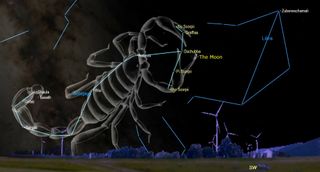Catch the moon near the claws of the Scorpius constellation Friday

See the moon shine near the claws of the Scorpius constellation just after dusk Friday night (Sept. 2).
The nearly half-illuminated moon rises tonight in the southwestern sky. It will appear near the row of small white stars that form the claws of Scorpius, which, from top to bottom, includes Jabbah or Nu Scorpii, Graffias or Acrab, Dschubba, Pi Scorpii, and Rho Scorpii.
While some of the stars are visible to the naked eye, others are best observed with binoculars or telescopes. Viewers using a backyard telescope at high magnification will be able to see that Nu Scorpii, Graffias, and Dschubba are close-together double stars, according to geophysicist Chris Vaughan, amateur astronomer with SkySafari Software who oversees Space.com's Night Sky calendar.
Related: How to Spot a Scorpion in the Night Sky
Pi Scorpii, or Fang, and Rho Scorpii are also multi-star systems. Pi Scorpii consists of three stars, which have a combined magnitude of 2.9, while Rho Scorpii is a double star with a magnitude of 3.87, which is bright enough to be seen with the naked eye.
Acrab, Dschubba and Fang are also commonly referred to as the Crown of the Scorpion because they form a curved arc that marks the scorpion's head.
Viewers can use the moon as a guide to find Scorpius, as it rises closest to Dschubba, which is easy to spot as it shines with a magnitude of 2.32. At this brightness, it can be seen by the naked eye under clear, dark skies.
Get the Space.com Newsletter
Breaking space news, the latest updates on rocket launches, skywatching events and more!

Looking for a telescope to see the moon near Scorpius? We recommend the Celestron Astro Fi 102 as the top pick in our best beginner's telescope guide.
The moon will reach its first quarter phase Saturday (Sept. 3) at 2:08 p.m. EDT (1808 GMT). Then, September's full moon will arrive in the early morning of Sept. 10 at 5:58 a.m. EDT (0958 GMT). Be sure to check out our guide for watching the full Harvest Moon.
You can check out our guides for the best binoculars and the best telescopes to spot Scorpius and the moon in the night sky. If you're hoping to capture a good photo of the night sky, check out our guide for photographing the moon, along with our recommendations for the best cameras for astrophotography and best lenses for astrophotography.
Editor's Note: If you snap a photo of the moon near the claws of Scorpius and would like to share it with Space.com's readers, send your photo(s), comments, and your name and location to spacephotos@space.com.
Follow Samantha Mathewson on Twitter @Sam_Ashley13. Follow us on Twitter @Spacedotcom or on Facebook.
Join our Space Forums to keep talking space on the latest missions, night sky and more! And if you have a news tip, correction or comment, let us know at: community@space.com.

Samantha Mathewson joined Space.com as an intern in the summer of 2016. She received a B.A. in Journalism and Environmental Science at the University of New Haven, in Connecticut. Previously, her work has been published in Nature World News. When not writing or reading about science, Samantha enjoys traveling to new places and taking photos! You can follow her on Twitter @Sam_Ashley13.
